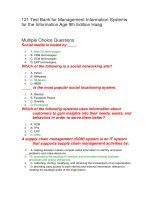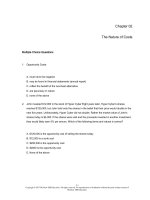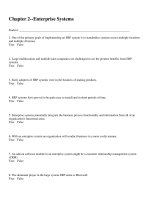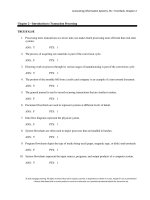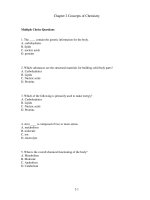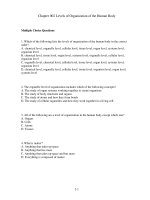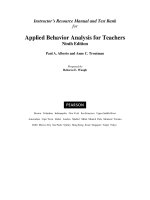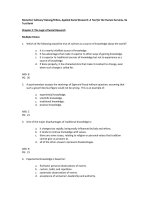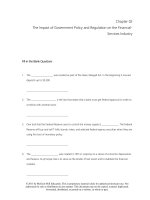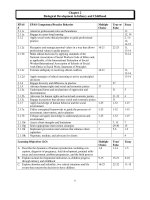Management information systems for the information age 9th edition haag test bank
Bạn đang xem bản rút gọn của tài liệu. Xem và tải ngay bản đầy đủ của tài liệu tại đây (424.22 KB, 120 trang )
Chapter 02
Major Business Initiatives: Gaining Competitive Advantage with IT
Multiple Choice Questions
1. The path a product or service follows from the originator of the product or service
to the end consumer is called ____.
A. inventory control
B. the market strategy
C. the distribution chain
D. transaction processing
2. Which of the following activities tracks inventory and information among business
processes and across companies?
A. Supply chain management (SCM)
B. Enterprise resource management (ERM)
C. Business intelligence (BI)
D. Distribution information systems (DIS)
3. A supply chain management (SCM) system is an IT system that supports supply
chain management activities by:
A. helping decision makers compile useful information to identify and solve
problems and make decisions.
B. automating the tracking of inventory and information among business processes
and across companies.
C. collecting, storing, modifying, and retrieving the transactions of an organization.
D. providing easy access to both internal and external information relevant to
meeting the strategic goals of the organization.
4. Most large manufacturing companies use _____ processes, which ensure that the
right parts are available as products in process move down the assembly line.
A. ready manufacturing
B. just-in-time manufacturing
C. hyper manufacturing
D. immediate production
5. Just-in-time (JIT) is:
A. a method for continuously improving the quality of products and processes.
B. a method of manufacturing where large inventories need to be maintained.
C. a method for producing or delivering a product or service precisely when the
customer wants it.
D. a method that considers the expenditure of resources for any goal other than
the creation of value for the end customer to be wasteful.
6. If you were to purchase a car and the assembly of that car was dictated by your
requirements before it was manufactured, you would be utilizing which type of
manufacturing process?
A. Customer-driven manufacturing
B. Just-in-time manufacturing
C. Customized construction
D. Transaction-based production
7. Which type of transportation uses multiple channels to transport products from
the manufacturing location to the customer destination?
A. Hyper
B. Divergent
C. Inter-modal
D. Complex
8. Which of the following supply chain activities ensures that the right quantity of
parts arrive at the right time for production or sale?
A. Logistics
B. Production
C. Cost and Price
D. Fulfillment
9. Which of the following supply chain activities keeps the cost of transporting
materials as low as possible consistent with safe and reliable delivery?
A. Logistics
B. Production
C. Cost and Price
D. Fulfillment
10. Which of the following supply chain activities ensures no sales are lost because
shelves are empty?
A. Logistics
B. Production
C. Cost and Price
D. Revenue and profit
11. In relation to SCM, what is an information partnership?
A. Sharing production information with potential customers
B. Two or more companies cooperating by integrating their IT systems
C. Competitive suppliers providing production schedules to the manufacturer
D. Functional areas within your business sharing information
12. You visit your local florist to order flowers for a party you were preparing for. The
florist, however, did not have the type of flower arrangement you hoped for but
the florist was able to immediately find, order, and deliver this arrangement
directly to your home from their supplier. What kind of relationship does this
represent?
A. An information partnership
B. A collaborative business
C. Dynamic communication
D. Customer sharing
13. Which of the following systems uses information about customers to gain insights
into their needs, wants, and behaviors in order to serve them better?
A. SCM
B. TPS
C. ERP
D. CRM
14. E-mail, fax, phone, and the Web are all ways in which most companies interact with
their customers. What term describes this method of communication?
A. Inter-modal communication
B. Customer collaborative systems
C. Multi-channel service delivery
D. Multi-path convergence
15. Which of the following is a fundamental goal of CRM systems?
A. To produce and deliver a product or service at the time the customer wants it.
B. To lower the costs of maintaining inventory systems.
C. To manage and track customer interactions.
D. To continuously improve the quality of products and processes.
16. What is the difference between SCM and CRM?
A. CRM records information about products and services; SCM records information
about customers.
B. CRM stores and processes transactional information; CRM stores and processes
business intelligence.
C. SCM manages production and delivery information; CRM manages customer
information.
D. CRM records and processes operational data; SCM records and processes
tactical information.
17. One of the primary functions of CRM is the sales force automation (SFA) system.
What is SFA's purpose?
A. To track all the steps in the sales process
B. To track the movements of salespeople
C. To track products as they move from inventory to the customer
D. To track the increase or decrease in sales
18. Which of the following CRM functions empower sales representatives with
information and business intelligence focused on customer buying patterns and
needs?
A. Customer service and support
B. Analytics
C. Sales force automation
D. Marketing campaign management
19. Which of the following steps is included in the sales process?
A. Analytics
B. Contact management
C. Customer service and support
D. Marketing campaign management
20. _____ are functions that support CRM after the sale.
A. Customer service and support
B. Analytics
C. Sales force automation
D. Marketing campaign management
21. Which of the following systems is the primary interface to customers and sales
channels, typically used to support customers or sales?
A. Back office systems
B. Front office systems
C. Decision support systems
D. Executive information systems
22. Which systems are typically used to fulfill and support customer orders?
A. Back office systems
B. Front office systems
C. Side office systems
D. Decision support systems
23. What is the difference between front and back office systems?
A. Front office systems are external systems; back office systems are internal.
B. Front office systems are Web based; back office systems are built on database
systems.
C. Front office systems process information in the beginning of a customer's
transaction; back office systems process information at the end of the
customer's transaction.
D. Front office systems focus on getting the sale; back office systems focus on
follow-up.
24. _____ is a delivery model for software in which you pay for software on a pay-peruse basis instead of buying the software outright.
A. SaaS
B. IaaS
C. PaaS
D. DSS
25. _____ was one of the first to offer SaaS for CRM software.
A. Oracle
B. SAP
C. Salesforce.com
D. Microsoft
26. An enterprise resource planning (ERP) system is:
A. a collection of integrated software for every functional area within an
organization.
B. a collaborative document management system that stores and manages
documents needed by the entire organization.
C. a database management system that maintains information on the information
resources for the entire enterprise.
D. a strategic planning methodology that promotes enterprise-wide planning
rather than decentralized planning.
27. Which of the following is a popular ERP vendor?
A. Apple
B. SAP
C. Symantec
D. Samsung
28. MailEx is a logistics company currently in need of an ERP product for managing the
firm better. Which of the following ERP vendors would best suit a logistics
company like MailEx?
A. Infor
B. Oracle/PeopleSoft
C. SAP
D. Microsoft
29. Which of the following ERP vendors is particularly used in financials?
A. Oracle
B. Infor
C. Microsoft
D. SAP
30. Forca, an aircraft manufacturing firm, needs an ERP product which specializes
particularly in module area of manufacturing. Which of the following ERP vendors
would best suit Forca?
A. Microsoft
B. Oracle/PeopleSoft
C. SAP
D. Infor
31. Allmart is a retail store chain with branches in more than 20 states in the US. They
are planning to change their ERP software to a more retail management-specific
one. Which of the following ERP vendors would best suit Allmart?
A. SAP
B. Microsoft
C. Oracle
D. Infor
32. The early stage of ERP was carried out in the 1970s through a system called ____.
A. Customer Relationship Management (CRM)
B. Database Management System (DBMS)
C. Materials Requirement Planning (MRP)
D. Decision Support System (DSS)
33. Organizations choose and deploy ERP systems for many different benefits and
reasons. Which of the following is a way that firms use to calculate such benefits?
A. Through CRM and SCM
B. Through clients and customers, who get the final benefits
C. Through calculation of ROI, weighted against the benefits expected
D. Through comparison of costs of using ERP and MRP
34. Qriosity Inc., a company of less than 100 seats, is in need of suitable ERP software.
The company having had a long, fruitful relationship with Microsoft for more than
10 years, wants to buy a Microsoft ERP product? Which of the following is suitable
ERP software for Qriosity Inc.?
A. Microsoft Dynamics AX
B. Microsoft Dynamics GP
C. Microsoft Dynamics SL
D. Microsoft Dynamics NAV
35. Which of the following ERP software is most suitable for Exacto, a precision
instrument manufacturer with 400 seats?
A. Infor ERP Solution
B. Microsoft Dynamics AX
C. SAP Business One
D. Intuit QuickBooks Enterprise
36. Which of the following ERP software is most suitable for Forca, an aircraft
manufacturer with more than 20000 employees?
A. SYSPRO
B. SAP Business One
C. Oracle ERP
D. Sage MAS 90 ERP
37. _____ is a collection of Web-based and mobile technologies that create true
interactivity among users, most usually allowing users to be both creators and
consumers of content.
A. World Wide Web
B. ERP
C. CRM
D. Social media
38. Social media is fueled by ____.
A. Web 2.0 technologies
B. CRM technologies
C. SCM technologies
D. ERP technologies
39. The Web 2.0:
A. is a technology that focuses on online collaboration, users as both creators and
modifiers of content, dynamic and customized information feeds, and many
other engaging Web-based services.
B. is a computer network consisting of a collection of internet sites that offer text
and graphics and sound and animation resources through the hypertext transfer
protocol.
C. is a reference that points to a whole document or to a specific element within a
document.
D. is a computer network consisting of a worldwide network of computer networks
that use the TCP/IP network protocols to facilitate data transmission and
exchange.
40. Which of the following is true of push and pull technologies?
A. The early Web was characterized by pushing static information.
B. In push technologies, organizations provide users with standardized information.
C. In pull technologies, organizations provide users with customized information
based on each user's individual profile.
D. In pull technologies, users research, find, request, and retrieve the information
they want.
41. Which of the following is a social networking site?
A. Yahoo
B. Wikipedia
C. MySpace
D. IMDB
42. _____ is a form of a microblog and allows you to send and receive text messages of
roughly 140 characters or fewer.
A. Huddle
B. A tweet
C. Sparks
D. A Circle
43. _____ is the professional equivalent of Facebook.
A. Google+
B. Orkut
C. LinkedIn
D. MySpace
44. Which of the following is a popular social shopping service?
A. Orkut
B. Bartab
C. Youtube
D. BBC
45. Games where thousands or millions of people play and interact in a robust virtual
world are known as ____.
A. social networking
B. social shopping
C. MMORPGs
D. multi-player gaming
46. Which of the following is a popular MMORPG?
A. Youtube
B. Google+
C. Groupon
D. World of Warcraft
47. All organizations are seeking ways to build sustainable practices and processes
that address the needs of the three Ps. What are the three Ps?
A. People, Plant, and Profit
B. Price, Promotion, and Place
C. Practicality, PR, and company Position
D. Promotion, PR, and People
48. _____ is the use of a mobile device and its location to check into locations such as
businesses and entertainment venues, find friends and their locations, and receive
rewards and take advantage of "specials" based on location.
A. MMORPG
B. Social locationing
C. Mobile locationing
D. Social gaming
49. Which of the following Google products is a social locationing system?
A. Google Maps
B. Google Plus
C. Google Latitude
D. Google Chat
50. _____ is the most popular social locationing system.
A. Geoloqi
B. Facebook Places
C. Gowalla
D. Foursquare
True / False Questions
51. The distribution chain is simply the path followed from the distributor of a product
or service to the end consumer.
True
False
52. A supply chain management system automates inventory tracking but still requires
that information be transferred manually.
True
False
53. Too many products on hand means that too much money is tied up in inventory
and it increases the risk of obsolescence.
True
False
54. Domestic supply chains rarely use inter-modal transportation.
True
False
55. Lower costs in the supply chain lead to increase in market share and top-line
revenue.
True
False
56. Revenue and profit are optimized by a well-designed supply chain management.
True
False
57. Information partnership occurs when all functional areas in a company cooperate
by integrating their IT systems.
True
False
58. Information partnerships require the integration of IT systems from two or more
independent companies.
True
False
59. A CRM system uses information about customers to gain insights into their needs,
wants, and behaviors in order to serve them better.
True
False
60. E-mail, fax, phone, and the Web are all ways in which most companies interact with
their customers. This approach is known as multi-channel service delivery.
True
False
61. Customer relationship management is simply a collection of software.
True
False
62. It is far more expensive to retain an existing customer than it is to acquire a new
customer.
True
False
63. Customer service and support functions are multi-channel.
True
False
64. Analytics are hard-core, numerical data that allow people to analyze operations
and processes and make better decisions.
True
False
65. Both the front office and the back office systems send customer information to the
corporate database.
True
False
66. Software-as-a-service (SaaS) is a delivery model in which you buy the software
outright.
True
False
67. All the associated costs of having software in-house represent variable costs.
True
False
68. An ERP system includes all technology systems and software in your organization.
True
False
69. Financial strength for research and development is considered one of the major
vendor qualities for ERP product selection and implementation.
True
False
70. CRM was a precursor technology to ERP.
True
False
71. An ERP system represents a massive, long-term business investment in a software
system with a single focus; such systems are often brittle, slow, and nonextensible.
True
False
72. An ERP system is required to have a decentralized database that organizes and
manages information.
True
False
73. ERP systems can improve organizations' functionalities in a single day.
True
False
74. ERP systems are expected to improve both back-office and front-office functions
simultaneously.
True
False
75. Social media is fueled by Web 1.0 technologies.
True
False
76. In pull technologies, users research, find, request, and retrieve the information they
want.
True
False
77. You can post information about yourself on Facebook.
True
False
